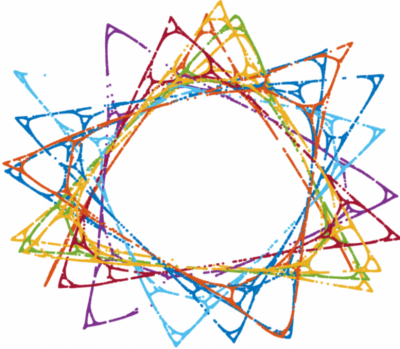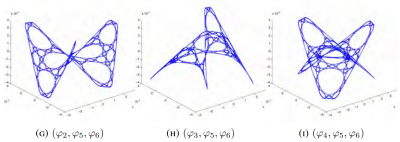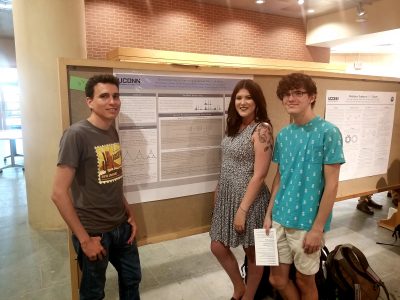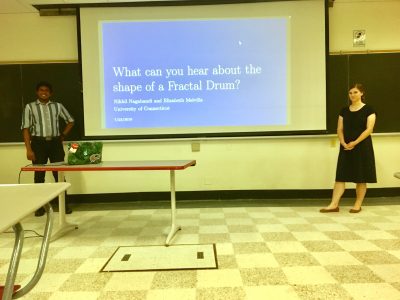Jason Freitas and Joshua Huang
Mentor: Oleksii Mostovyi
Jason Freitas and Joshua Huang
Mentor: Oleksii Mostovyi


REU participants:
Bobita Atkins, Massachusetts College of Liberal Arts
Ashka Dalal, Rose-Hulman Institute of Technology
Natalie Dinin, California State University, Chico
Jonathan Kerby-White, Indiana University Bloomington
Tess McGuinness, University of Connecticut
Tonya Patricks, University of Central Florida
Genevieve Romanelli, Tufts University
Yiheng Su, Colby College
Mentors: Bernard Akwei, Rachel Bailey, Luke Rogers, Alexander Teplyaev
Convergence, optimization and stabilization of singular eigenmaps
B.Akwei, B.Atkins, R.Bailey, A.Dalal, N.Dinin, J.Kerby-White, T.McGuinness, T.Patricks, L.Rogers, G.Romanelli, Y.Su, A.Teplyaev
Eigenmaps are important in analysis, geometry and machine learning, especially in nonlinear dimension reduction.
Versions of the Laplacian eigenmaps of Belkin and Niyogi are a widely used nonlinear dimension reduction technique in data analysis. Data points in a high dimensional space \(\mathbb{R}^N\) are treated as vertices of a graph, for example by taking edges between points separated by distance at most a threshold \(\epsilon\) or by joining each vertex to its \(k\) nearest neighbors. A small number \(D\) of eigenfunctions of the graph Laplacian are then taken as coordinates for the data, defining an eigenmap to \(\mathbb{R}^D\). This method was motivated by an intuitive argument suggesting that if the original data consisted of \(n\) sufficiently well-distributed points on a nice manifold \(M\) then the eigenmap would preserve geometric features of \(M\).
Several authors have developed rigorous results on the geometric properties of eigenmaps, using a number of different assumptions on the manner in which the points are distributed, as well as hypotheses involving, for example, the smoothness of the manifold and bounds on its curvature. Typically, they use the idea that under smoothness and curvature assumptions one can approximate the Laplace-Beltrami operator of \(M\) by an operator giving the difference of the function value and its average over balls of a sufficiently small size \(\epsilon\), and that this difference operator can be approximated by graph Laplacian operators provided that the \(n\) points are sufficiently well distributed.
In the present work we consider several model situations where eigen-coordinates can be computed analytically as well as numerically, including the intervals with uniform and weighted measures, square, torus, sphere, and the Sierpinski gasket. On these examples we investigate the connections between eigenmaps and orthogonal polynomials, how to determine the optimal value of \(\epsilon\) for a given \(n\) and prescribed point distribution, and the dependence and stability of the method when the choice of Laplacian is varied. These examples are intended to serve as model cases for later research on the corresponding problems for eigenmaps on weighted Riemannian manifolds, possibly with boundary, and on some metric measure spaces, including fractals.
Approximation of the eigenmaps of a Laplace operator depends crucially on the scaling parameter \(\epsilon\). If \(\epsilon\) is too small or too large, then the approximation is inaccurate or completely breaks down. However, an analytic expression for the optimal \(\epsilon\) is out of reach. In our work, we use some explicitly solvable models and Monte Carlo simulations to find the approximately optimal value of \(\epsilon\) that gives, on average, the most accurate approximation of the eigenmaps.
Our study is primarily inspired by the work of Belkin and Niyogi “Towards a theoretical foundation for Laplacian-based manifold methods.”
Talk: Laplacian Eigenmaps and Chebyshev Polynomials
Talk: A Numerical Investigation of Laplacian Eigenmaps
Talk: Analysis of Averaging Operators
Intro Text: Graph Laplacains, eigen-coordinates, Chebyshev polynomials, and Robin problems
Intro Text: A Numerical Investigation of Laplacian Eigenmaps
Intro Text: Comparing Laplacian with the Averaging Operator
Poster: Laplacian Eigenmaps and Orthogonal Polynomials
Results are presented at the 2023 Young Mathematicians Conference (YMC) at the Ohio State University, a premier annual conference for undergraduate research in mathematics, and at the 2024 Joint Mathematics Meetings (JMM) in San Francisco, the largest mathematics gathering in the world.
Group Members: Tyler Campos, Andrew Gannon, Benjamin Hanzsek-Brill, Connor Marrs, Alexander Neuschotz, Trent Rabe and Ethan Winters.
Mentors: Rachel Bailey, Fabrice Baudoin, Masha Gordina
Overview: We study and simulate on computers the fractional Gaussian fields and their discretizations on surfaces like the two-dimensional sphere or two-dimensional torus. The study of the maxima of those processes will be done and conjectures formulated concerning limit laws. Particular attention will be paid to log-correlated fields (the so-called Gaussian free field).
Involve (2022), Vol. 15(4), pp. 649-668. [published version] [arXiv]
accepted in the Missouri Journal of Mathematical Sciences (2023)
Séminaire Lotharingien de Combinatoire (2021)
Sém. Lothar. Combin. 85B (2021), Art. 14, 12 pp.
Proceedings of the 33rd Conference on Formal Power
Series and Algebraic Combinatorics
Ben Drucker, Eli Garcia, Emily Gunawan, and Rose Silver
A box-ball system is a collection of discrete time states representing a permutation,
on which there is an action called a BBS move. After a finite number of BBS moves
the system decomposes into a collection of soliton states; these are weakly
increasing and invariant under BBS moves. The students proved that when this
collection of soliton states is a Young tableau or coincides with a partition of a type
described by Robinson-Schensted (RS), then it is an RS insertion tableau. They also
studied the number of steps required to reach this state.
Samantha Forshay, Leng Mawi, Matthew Peeks.
Chris Hayes, Luke Rogers, Sasha Teplyaev.
A celebrated result in analysis and probability on fractals is the construction of a diffusion on the standard Sierpinski Carpet by Barlow and Bass. One key part of their argument is a pair of upper and lower estimates for the resistances of precarpets: if \(K_n\) denotes the level \(n\) approximation of the carpet and \(E_n\) is the minimal Dirichlet energy of a function that is identically 1 on one side of the carpet and identically 0 on the other side, then there are constants \(0<c\leq C< \infty\) so that \(c\rho^n\leq E_n\leq C\rho^n\). Estimates for \(\rho\) are known but the exact value is not.
The Sierpinski-type carpets to which the preceding estimates of resistance have been extended are all self-similar. By contrast, in the setting of post-critically finite fractals, resistance scaling has been successfully studied also in the self-affine case, initially by Fitzsimmons, Hambly and Kumagai.
The goal of this project was to investigate what aspects of the Barlow-Bass approach to resistance estimation on carpets could be extended to the self-affine case, and to make numerical computations of the behavior of resistance in this setting and its dependence on the affine scalings.

Madison Phelps, Brett Hungar, Johnathan Wheeler.
Gamal Mograby, Luke Rogers, Sasha Teplyaev.
Physicists and mathematicians have used the self-similar nature of certain fractals to develop and study analytical structures on fractal spaces. We examine the analytical structure of a class of fractals that arise as limit sets of the Schreier graphs of the action of self-similar groups on infinite n-ary trees. In particular, we consider how the spectrum of a Laplacian operator on one level of a Schreier graph relates to the spectrum on the next level, a technique known as spectral decimation.
Grigorchuk and collaborators have developed a method to spectrally decimate Schreier graphs of several
important self-similar groups, and have derived significant consequences about the structure of amenable groups. Their method is related to a notion of spectral similarity arising from the work of Fukushima-Shima and Malozemov-Teplyaev. In the latter, a sufficient condition for spectral decimation for fractal graphs is obtained. We consider the analogous question for Schreier graphs of self-similar groups with the goal of understanding the class to which Grigorchuk’s approach is applicable.

Sarah Boese, Tracy Cui, Sam Johnston
Gianmarco Molino, Olekisii Mostovyi
In practice, financial models are not exact — as in any field, modeling based on real data introduces some degree of error. However, we must consider the effect error has on the calculations and assumptions we make on the model. In complete markets, optimal hedging strategies can be found for derivative securities; for example, the recursive hedging formula introduced in Steven Shreve’s “Stochastic Calculus for Finance I” gives an exact expression in the binomial asset model, and as a result the unique arbitrage-free price can be computed at any time for any derivative security.
In incomplete markets this cannot be accomplished; one possibility for computing optimal hedging strategies is the method of sequential regression. We considered this in discrete-time; in the (complete) binomial model we showed that the strategy of sequential regression introduced by Follmer and Schweizer is equivalent to Shreve’s recursive hedging formula, and in the (incomplete) trinomial model we both explicitly computed the optimal hedging strategy predicted by the Follmer-Schweizer decomposition and we showed that the strategy is stable under small perturbations.

Elizabeth Melville, Nikhil Nagabandi.
Gamal Mograby, Luke Rogers, Sasha Teplyaev.
Analytic structures on fractals have been analyzed extensively in the past 50 years both because of their interesting mathematical properties and their potential applications in physics. One important question in this area is how the spectrum of a Laplacian on a fractal reflects its geometry; one version of the corresponding problem for domains in Euclidean space was famously described in Kac’s question ”Can you hear the shape of a drum?”.
Some features of the spectra of self-similar sets, such as the asymptotic behavior of the eigenvalue counting function, can be obtained using renewal theory (as in the work of Kigami-Lapidus), but our interest is in more precise results that give the locations and multiplicities of eigenvalues explicitly. These are connected to a long strand of research in mathematical physics about the structure of spectra of Schrodinger operators ¨ and their relation to topological invariants of the underlying space (prominent results in this area are due to Landau, Peierls, Harper, Moser, Bellissard, and, recently, Avila and Jitomirskaya). One name for these results is gap-labeling theorems. For certain highly-symmetric self-similar sets, the computation of the gap structure of the Laplacian spectrum is possible using spectral decimation. We use this method to explicitly compute the gap structure for the Laplacian on a particular two-point self-similar graph and its fractal limit, and for Sierpinski graphs and the Sierpinski gasket.